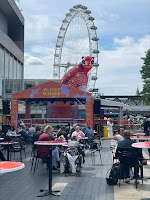Animals: Art, Science and Sound

Disappointing exhibition at the British Library on how animals have been documented and researched through art, science and sound. I just say disappointing as the show felt like it was aimed at children and fair enough it is the summer holidays. I’d hoped it would look at the history of how we have recorded animals but instead it looked at the animals themselves via the themes of darkness, water, land and air. The history was hidden in there if you looked but on the surface, it was more about the animals. There were a number of children engaging well with the show via a good activities book. A small criticism is that this encouraged them to use the space where the labels were to lean on and write so they were often hard to read. I must admit I think I would have found it quite a dry show as a child but then I was never really that into animals. There were some amazing books and objects within the show. There was a copy of George Stubbs private publication on the anatomy of the h...




















